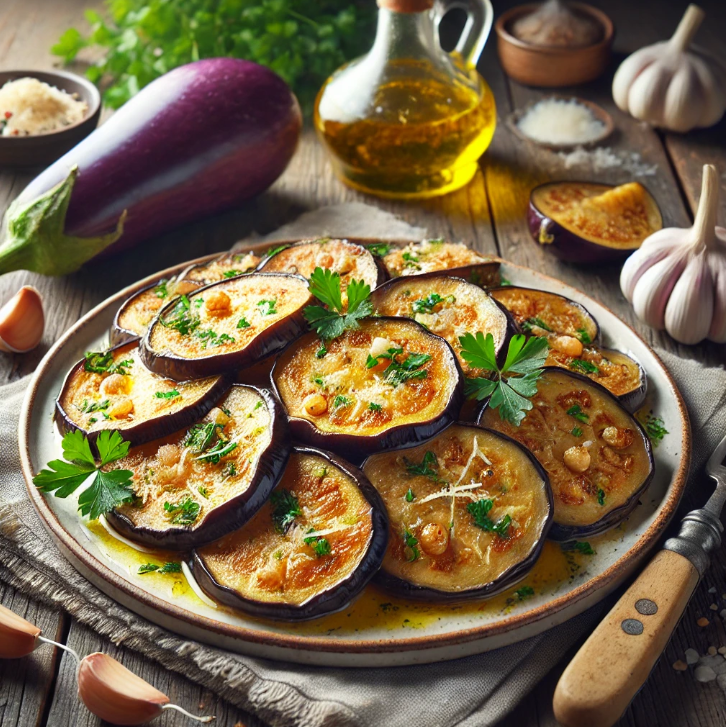If you’ve ever wondered how to make eggplant truly shine, look no further than sautéed eggplant. This simple yet flavorful cooking method turns an ordinary vegetable into a golden-brown, tender side dish or main course. Whether you’re whipping it up as a quick addition to dinner or using it as a base for more elaborate recipes, sautéed eggplant is as versatile as it is delicious.
In this guide, we’ll explore everything you need to know about making the perfect sautéed eggplant. From selecting the best ingredients to mastering the cooking techniques, you’ll learn how to create a dish that’s both healthy and bursting with flavor. Plus, we’ll share popular recipes, expert tips, and creative ways to customize your dish. Let’s get started!
Table of Contents
Introduction to Sautéed Eggplant
Before diving into the steps and ingredients, let’s take a closer look at what makes sautéed eggplant such a standout dish.
What is Sautéed Eggplant?
Sautéed eggplant is a cooking method where eggplant slices or cubes are quickly cooked in a hot pan with a small amount of oil or fat. This technique creates a tender, caramelized exterior while keeping the inside soft and flavorful. It’s a versatile dish that can be served as a side, used in sandwiches, or added to pasta and salads.
Why Sautéed Eggplant is a Versatile Dish
What makes sautéed eggplant so special is its adaptability. It absorbs the flavors of the herbs, spices, and oils you cook it with, making it a perfect canvas for culinary creativity. Whether you prefer Mediterranean, Asian, or Italian flavors, this dish can easily be tailored to match your preferences.
The Rise in Popularity of Sautéed Dishes
Sautéed vegetables, including eggplant, have become a staple in kitchens worldwide thanks to their quick preparation and health benefits. Cooking eggplant this way retains its nutrients while adding a rich, caramelized flavor that appeals even to those who aren’t usually fans of this vegetable.
Essential Ingredients for Sautéed Eggplant
The magic of a great sautéed eggplant dish lies in the quality and combination of ingredients. With the right elements, you can create a flavorful, healthy dish that’s easy to prepare and hard to resist.
Choosing the Right Eggplant Variety
Not all eggplants are created equal when it comes to sautéing. Smaller varieties like Italian or Japanese eggplants are ideal because they have fewer seeds, a sweeter taste, and a tender texture. When selecting eggplants, look for ones that are firm, shiny, and free of blemishes. Smaller eggplants also absorb less oil during cooking, making them a healthier option.
Flavorful Oils and Fats for Cooking
The choice of oil significantly impacts the flavor of your sautéed eggplant. Olive oil is a classic choice for its rich, slightly fruity taste that complements eggplant beautifully. For a more neutral flavor, opt for avocado oil or vegetable oil. If you’re feeling adventurous, try adding a knob of butter or a splash of sesame oil for extra depth.
Herbs, Spices, and Seasonings to Enhance Flavor
Herbs and spices elevate the taste of sautéed eggplant, transforming it from a simple side dish to a flavorful masterpiece. Fresh garlic, thyme, or rosemary add earthy notes, while spices like smoked paprika or cumin provide warmth and complexity. A sprinkle of salt and freshly cracked pepper is essential to bring out the natural flavors of the eggplant.
Step-by-Step Guide to Sautéing Eggplant
Sautéing eggplant is easier than you might think, but it does require a few key techniques to achieve the perfect balance of tenderness and caramelization. Follow these steps for the best results.
Preparing Eggplant: Slicing and Salting Techniques
Begin by slicing the eggplant into even rounds or cubes. To reduce bitterness and remove excess moisture, sprinkle the pieces with salt and let them sit for 20–30 minutes. This step, known as sweating, prevents the eggplant from becoming soggy and helps it cook evenly. Afterward, rinse the slices and pat them dry with a paper towel.
Cooking Methods: Pan-Sautéing vs. Stir-Frying
When it comes to cooking sautéed eggplant, you have options. Pan-sautéing involves cooking the eggplant in a single layer in a hot skillet, ensuring each piece gets a golden-brown crust. Stir-frying, on the other hand, is quicker and requires tossing the eggplant constantly in a wok or large pan over high heat. Both methods deliver delicious results, so choose the one that suits your style.
Tips for Achieving the Perfect Texture
To achieve tender yet slightly crispy sautéed eggplant, use a hot pan and don’t overcrowd it. Too many pieces at once can cause the eggplant to steam instead of sauté. Add oil in small amounts as needed to prevent sticking and enhance caramelization.
Common Mistakes to Avoid While Sautéing Eggplant
Avoid overcooking the eggplant, as it can turn mushy and lose its appeal. Additionally, using too much oil can make the dish greasy since eggplant absorbs oil quickly. By salting the eggplant beforehand and using a non-stick or well-seasoned skillet, you can prevent these issues.
Popular Sautéed Eggplant Recipes
Sautéed eggplant is incredibly versatile and serves as a base for many creative recipes. From classic flavors to international inspirations, there’s something for everyone.
Garlic and Balsamic Sautéed Eggplant
This simple yet flavorful recipe combines tender eggplant slices with the robust taste of garlic and a splash of balsamic vinegar. The acidity of the vinegar balances the richness of the eggplant, making it an ideal side dish or topping for crusty bread.
Mediterranean-Style Sautéed Eggplant with Herbs
For a Mediterranean twist, sauté eggplant with olive oil, oregano, thyme, and fresh parsley. Adding a handful of cherry tomatoes and crumbled feta cheese brings brightness and a creamy finish to this dish. It pairs wonderfully with grilled meats or seafood.
Spicy Asian-Inspired Sautéed Eggplant
Transform your eggplant into a spicy delight with soy sauce, ginger, garlic, and a touch of chili oil. Stir-fried with scallions and sesame seeds, this version is perfect over steamed rice or noodles for a quick, satisfying meal.
Sautéed Eggplant with Mushrooms and Onions
Combine sliced mushrooms and caramelized onions with sautéed eggplant for a hearty, earthy dish. Adding a dash of white wine during cooking enhances the flavors and makes it a delightful accompaniment to roasted chicken or steak.
For more ideas, visit this Sautéed Eggplant Recipe to explore other creative options!
Health Benefits of Sautéed Eggplant
In addition to being delicious, sautéed eggplant is packed with health benefits. This nutrient-rich dish is perfect for those seeking both flavor and wellness.
Eggplant as a Nutritional Powerhouse
Eggplants are low in calories and high in fiber, making them excellent for digestion and weight management. They’re also rich in antioxidants like nasunin, which supports brain health, and contain vitamins like B6, potassium, and magnesium.
Low-Calorie and Low-Carb Benefits
For those watching their calorie intake or following a low-carb diet, sautéed eggplant is an excellent choice. Its satisfying texture and ability to absorb bold flavors make it a great alternative to heavier, carb-rich sides.
How to Keep Sautéed Eggplant Healthy
To maximize the health benefits, use heart-healthy oils like olive or avocado oil in moderation. Avoid overloading the dish with too much salt or heavy sauces, and balance it with fresh herbs and vegetables to keep it light and nutritious.
FAQs About Sautéed Eggplant
When preparing sautéed eggplant, a few common questions often arise. Here are answers to help you achieve the best results every time.
How Do I Prevent it from Becoming Soggy?
One of the biggest challenges when cooking sautéed eggplant is maintaining its texture. To avoid sogginess, start by salting the eggplant slices or cubes to draw out excess moisture. Use a hot pan and cook in small batches to ensure each piece gets a golden-brown crust without steaming.
What Are the Best Side Dishes to Pair with It?
It pairs beautifully with a wide range of dishes. Serve it alongside grilled chicken, fish, or lamb for a hearty meal. It also complements lighter fare like quinoa salads, roasted vegetables, or fresh pita bread with hummus for a Mediterranean-inspired spread.
Can I Freeze It for Later?
Yes, it can be frozen, though its texture may change slightly after reheating. To freeze, let the cooked eggplant cool completely, then place it in an airtight container or freezer-safe bag. Thaw it in the refrigerator before reheating in a skillet for the best texture.
What Are Some Creative Ways to Use The Leftover ?
Leftovers are a great opportunity to get creative! Add it to pasta dishes, layer it in lasagna, or use it as a topping for pizza. You can also mix it into grain bowls or blend it with tahini and garlic to create a smoky eggplant dip.
Tips and Tricks for Perfect Sautéed Eggplant
Mastering sautéed eggplant takes a little know-how, but these tips and tricks will ensure a delicious dish every time.
Using Fresh Ingredients for Better Flavor
Fresh, high-quality eggplants make all the difference. Choose eggplants with smooth, unblemished skin and a firm texture. Fresh garlic, herbs, and spices also elevate the overall flavor, ensuring a vibrant and satisfying dish.
Cooking with Different Types of Oils for Unique Results
Experimenting with various cooking oils can give your sautéed eggplant a unique twist. Olive oil is a classic choice, but sesame oil adds a nutty aroma that’s perfect for Asian-inspired recipes. For a richer flavor, try combining butter with oil to create a golden, caramelized crust.
Customizing Sautéed Eggplant to Suit Any Cuisine
Sautéed eggplant is a blank canvas for global flavors. Add soy sauce, ginger, and chili flakes for an Asian-style dish, or toss it with basil, oregano, and Parmesan for an Italian-inspired side. The possibilities are endless, making it a versatile addition to any meal.
Creative Twists and Customizations
One of the best things about sautéed eggplant is its versatility. With a few creative adjustments, you can turn this classic dish into something truly unique.
Adding a Sweet and Savory Balance
Combine the natural earthiness of sautéed eggplant with contrasting flavors. Add a drizzle of honey or maple syrup along with a splash of soy sauce for a sweet and savory Asian-inspired twist. Pairing it with caramelized onions or dried cranberries can also create a delightful balance.
Infusing Global Flavors
Give it a global flair by experimenting with spices and sauces. Toss it with curry powder and coconut milk for an Indian-inspired dish, or blend it with miso paste and sesame seeds for a Japanese-style side. These variations can completely transform your dish while maintaining the tender, caramelized texture of the eggplant.
Conclusion and Final Thoughts
It is a dish that combines simplicity with bold flavors, making it a must-have in any home cook’s repertoire. From its ease of preparation to its ability to absorb and enhance any seasoning, it’s no wonder this dish has become a favorite around the world.
Whether you’re making a quick side for dinner or incorporating it into a more elaborate meal, it offers endless possibilities. By following the tips and recipes outlined in this guide, you’ll master the art of sautéing and create dishes that are as delicious as they are versatile.
So, grab some fresh eggplants, heat up your skillet, and let your creativity shine. With sautéed eggplant, the only limit is your imagination!
For more delicious ways to prepare it, check out the collection of recipes on Allrecipes. From quick weeknight dishes to gourmet options, you’ll find plenty of inspiration to elevate your cooking!


